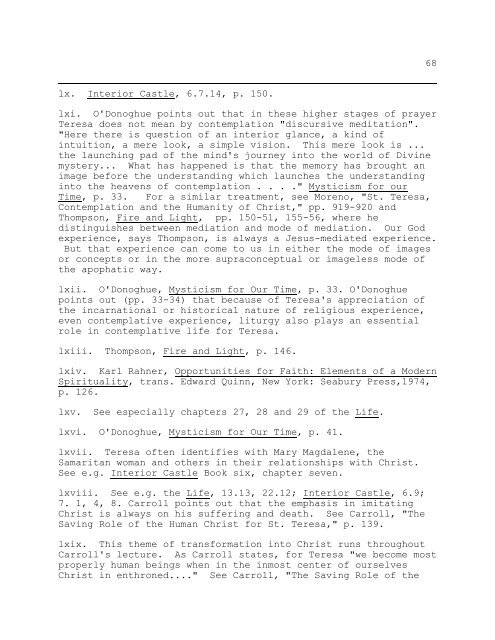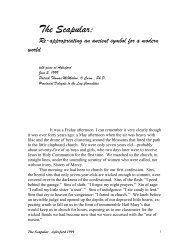Christocentrism of Charism – Buggert - CarmelStream
Christocentrism of Charism – Buggert - CarmelStream
Christocentrism of Charism – Buggert - CarmelStream
Create successful ePaper yourself
Turn your PDF publications into a flip-book with our unique Google optimized e-Paper software.
lx. Interior Castle, 6.7.14, p. 150.<br />
lxi. O'Donoghue points out that in these higher stages <strong>of</strong> prayer<br />
Teresa does not mean by contemplation "discursive meditation".<br />
"Here there is question <strong>of</strong> an interior glance, a kind <strong>of</strong><br />
intuition, a mere look, a simple vision. This mere look is ...<br />
the launching pad <strong>of</strong> the mind's journey into the world <strong>of</strong> Divine<br />
mystery... What has happened is that the memory has brought an<br />
image before the understanding which launches the understanding<br />
into the heavens <strong>of</strong> contemplation . . . ." Mysticism for our<br />
Time, p. 33. For a similar treatment, see Moreno, "St. Teresa,<br />
Contemplation and the Humanity <strong>of</strong> Christ," pp. 919-920 and<br />
Thompson, Fire and Light, pp. 150-51, 155-56, where he<br />
distinguishes between mediation and mode <strong>of</strong> mediation. Our God<br />
experience, says Thompson, is always a Jesus-mediated experience.<br />
But that experience can come to us in either the mode <strong>of</strong> images<br />
or concepts or in the more supraconceptual or imageless mode <strong>of</strong><br />
the apophatic way.<br />
lxii. O'Donoghue, Mysticism for Our Time, p. 33. O'Donoghue<br />
points out (pp. 33-34) that because <strong>of</strong> Teresa's appreciation <strong>of</strong><br />
the incarnational or historical nature <strong>of</strong> religious experience,<br />
even contemplative experience, liturgy also plays an essential<br />
role in contemplative life for Teresa.<br />
lxiii. Thompson, Fire and Light, p. 146.<br />
lxiv. Karl Rahner, Opportunities for Faith: Elements <strong>of</strong> a Modern<br />
Spirituality, trans. Edward Quinn, New York: Seabury Press,1974,<br />
p. 126.<br />
lxv. See especially chapters 27, 28 and 29 <strong>of</strong> the Life.<br />
lxvi. O'Donoghue, Mysticism for Our Time, p. 41.<br />
lxvii. Teresa <strong>of</strong>ten identifies with Mary Magdalene, the<br />
Samaritan woman and others in their relationships with Christ.<br />
See e.g. Interior Castle Book six, chapter seven.<br />
lxviii. See e.g. the Life, 13.13, 22.12; Interior Castle, 6.9;<br />
7. 1, 4, 8. Carroll points out that the emphasis in imitating<br />
Christ is always on his suffering and death. See Carroll, "The<br />
Saving Role <strong>of</strong> the Human Christ for St. Teresa," p. 139.<br />
lxix. This theme <strong>of</strong> transformation into Christ runs throughout<br />
Carroll's lecture. As Carroll states, for Teresa "we become most<br />
properly human beings when in the inmost center <strong>of</strong> ourselves<br />
Christ in enthroned...." See Carroll, "The Saving Role <strong>of</strong> the<br />
68



